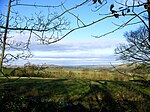Waterhouses railway station (Staffordshire)
Disused railway stations in StaffordshireFormer Leek and Manifold Light Railway stationsFormer North Staffordshire Railway stationsPages with no open date in Infobox stationRailway stations in Great Britain closed in 1943 ... and 3 more
Railway stations in Great Britain opened in 1905Staffordshire MoorlandsUse British English from March 2017
Waterhouses railway station was a railway station that served the village of Waterhouses, Staffordshire. It was opened jointly by the North Staffordshire Railway (NSR) and the Leek and Manifold Valley Light Railway (L&MVLR) in 1905 and closed in 1943.
Excerpt from the Wikipedia article Waterhouses railway station (Staffordshire) (License: CC BY-SA 3.0, Authors).Waterhouses railway station (Staffordshire)
Ashbourne Road, Staffordshire Moorlands
Geographical coordinates (GPS) Address Nearby Places Show on map
Geographical coordinates (GPS)
| Latitude | Longitude |
|---|---|
| N 53.0487 ° | E -1.8742 ° |
Address
Manifold Trail
Ashbourne Road
ST10 3JS Staffordshire Moorlands
England, United Kingdom
Open on Google Maps





